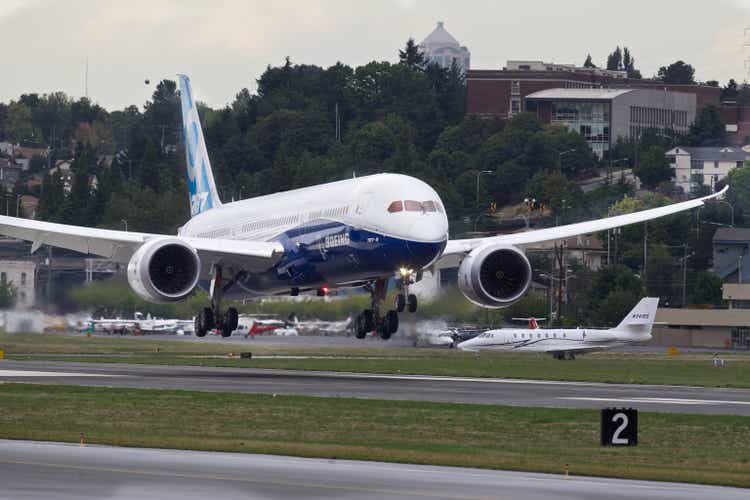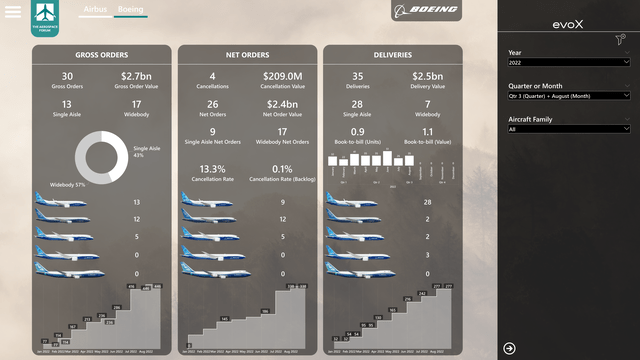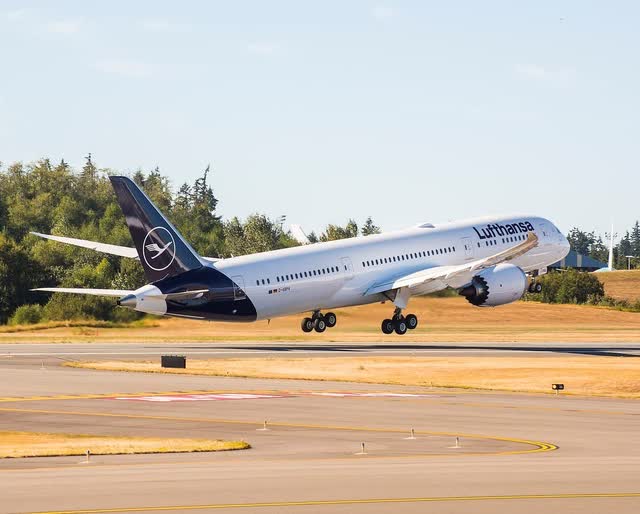Stephen Brashear/Getty Images News
In July, The Boeing Company (NYSE:BA) saw an uptick in orders following a successful Farnborough International Airshow. However, absent of sales to China, Airbus (OTCPK:EADSF, OTCPK:EADSY) remains in the lead in the annual order battle. While the end of September is already approaching, meaning that September order and delivery figures will be released by Boeing within weeks, I wanted to take a look at orders and deliveries in August as part of the monthly coverage of order and delivery numbers.
For this report, I will be using the evoX order and delivery monitor developed by The Aerospace Forum. For those who have been following the monthly order and delivery reports that I write for Airbus and Boeing, you might notice that this monitor looks completely different. So, I wanted to briefly introduce this new product that I will occasionally use as the backbone for investor updates. Over time, our data analytics capabilities have significantly expanded. With that come new insights on how to do things better. As a result, I have launched evoX, which combines front-end efforts and back-end improvements to improve our data analytics tools.
The evoX platform introduces a completely new look for interactive monitors, but it does not stop there. We consolidated various monitors and pages into one, making more data accessible with a single tool and from the same data we present more information to you. So, we are better leveraging the hundreds of thousands of datapoints we got, which allows us to better highlight the data-driven approach of the analysis.
Just like before, using these tools we are able to analyze orders and deliveries and see where manufacturers are falling short, meeting or exceeding expectations.
A Timid Order Month For Boeing
Boeing orders and deliveries August 2022 (The Aerospace Forum)
In August, Boeing booked 30 orders valued $2.7 billion consisting of 13 single aisle jets and 17 wide body aircraft, marking a sequential decline of 100 orders driven by the timing of the Farnborough International Airshow:
- AerCap (AER) ordered five Boeing 787-9s.
- American Airlines (AAL) ordered two Boeing 737 MAX aircraft.
- Israel finalized an order for four KC-46A tankers.
- An unidentified customer ordered 11 Boeing 737 MAX aircraft.
- UPS (UPS) ordered eight Boeing 767-300Fs.
During the month, the following changes were made to the order book:
- Aerolineas Argentinas cancelled an order for one Boeing 737 MAX.
- Okay Airways cancelled an order for two Boeing 737 MAX aircraft.
- An unidentified customer cancelled an order for one Boeing 737 MAX.
- Southwest Airlines was identified as the customer for 72 Boeing 737 MAX aircraft.
August was not a spectacular month for Boeing’s order tally. Boeing received 13 gross orders for the MAX, but had to remove four orders from the books. More interesting were the wide body orders. Boeing added orders for the Dreamliner, which, given the issues that circled the Dreamliner for the past years, is not a common thing. The U.S. jet maker also saw the continued strength of the Boeing 767 platform with defense and freighter orders.
In August, Boeing logged 30 gross, valued $2.7B, while it scrapped four orders valued $209 million from the books, bringing the net orders to 26 orders valued $2.4 billion. A year ago, the U.S. jet maker booked 53 orders and 30 cancellations, bringing its net orders to 23 units with a net order value of $2.8 billion. So, we see that net order inflow increased slightly.
Year-to-date, the Boeing booked 446 gross orders and 108 cancellations, bringing the net orders to 338 units with a net order value of $23 billion. In the first eight months of 2021, Boeing booked 683 gross orders and 280 net orders with a net value of $22.4 billion. What we are seeing is that net orders are up significantly, but this is not reflected as much in the order value, because the order mix this year is tilted more towards single-aisle orders than last year.
Deliveries Remain Underwhelming
Boeing delivered first Boeing 787 to Lufthansa (Boeing )
In August, Boeing delivered 35 jets compared to 26 in the previous month. The jet maker delivered 28 single-aisle jets and seven wide-body aircraft with a combined value of $2.5 billion:
- A total of 28 Boeing 737s was delivered, consisting of one Boeing P-8A and 27 Boeing 737 MAX aircraft.
- Two Boeing 767-300Fs were delivered to FedEx (FDX).
- Boeing delivered three Boeing 777Fs.
- Boeing delivered two Boeing 787s; one -10 and one -9 variant.
In August, deliveries increased sequentially from 26 to 35. That is partially caused by the low delivery numbers in July, which marks the start of a quarter. As jet makers try to squeeze out some deliveries in the final month of the quarter, the subsequent month tends to be somewhat soft in terms of deliveries.
Overall, Boeing’s delivery numbers fail to impress me. In August, the U.S. jet maker delivered single aisle jets at a rate that is below the production rate, meaning that the inventory did not decrease. That is barely a demand problem, as demand for jets is currently quite high, but the issues in the supply chain primarily on turbofans are so big that increasing those deliveries significantly is a major challenge. It also somewhat shows why Boeing is taking engines off inventoried aircraft to streamline production and even decided to remarket jets initially built for China.
The bigger positive, without doubt, was the return of the Boeing 787 in the delivery mix. Boeing delivered two Dreamliners to customers in Europe. The jet maker also handed over two Dreamliners to American Airlines, but these aircraft were not recognized as deliveries, as the jets flew to Victorville for contracted cabin work to be carried out. Once this is complete, Boeing will officially recognize the deliveries.
Compared to last year, deliveries increased by 13 units while the delivery value increased by $0.7 billion. Year-to-date, Boeing delivered 277 aircraft valued at $18.2 billion compared to 206 aircraft valued at $15.9 billion last year. Year-to-date numbers show that Boeing deliveries are significantly higher, driven by the Boeing 737 MAX program, but the value did not expand as much, as Boeing delivered 14 Dreamliners last year in a brief window of four months and has yet to significantly catch up on deliveries this year for the composite jet.
The book-to-bill ratio for the month was 0.9 on unit basis and 1.1 on dollar value basis. For the first nine months of the year, the gross book-to-bill is 1.6 in terms of units and 1.7 in terms of value, while the cancellation rate is 24% and 2.1% when measured against the backlog. The book-to-bill ratio for the year is looking extremely strong. This is driven by strong order inflow, but also by the underwhelming delivery numbers due to supply chain issues. So, book-to-bill ratios higher than one do show balance or oversold positions in general, but in this case they also reflect the big challenges when it comes to hiking production.
Conclusion: Bullish Future, Somewhat Bearish Near-Term Reality For BA
What holds for Boeing is that the orders in August were not good or bad. We see continued demand for the Boeing 737 MAX and we even saw orders for the Dreamliner while the Boeing 767 continues to underline its market appeal. However, deliveries are where Boeing currently has to deliver quite literally, and they are not doing that. The obvious positive is the restart of Boeing 787 Dreamliner deliveries, and I believe that is going to help the company improve results going forward. Where Boeing still is not impressing much is the Boeing 737 MAX deliveries. That continues to be a point of disappointment.
However, the reality is that supply chain challenges for jet makers currently are so big that delivering in-line with production rates is difficult to achieve. Boeing should have had significant leverage with its inventory of hundreds of pre-built jets, but we don’t see that back in the numbers.
Does it mean, it is time to turn bearish? Maybe. If you are scared of a recession, industrials are not the place to be, and in the order and delivery numbers you might find a reason to sell your Boeing stock. However, I am in it for the long term. The positives I am currently seeing include a return of the Dreamliner in the delivery mix. While MAX deliveries have not ramped up as much as desired, they are still going to be significantly higher than last year. So, if you liked Boeing last year, there still are reasons to like the stock today.


Be the first to comment